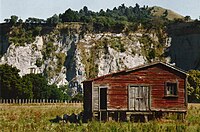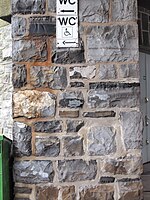Greywacke


Greywackeorgraywacke(Germangrauwacke,signifying a grey, earthy rock) is a variety ofsandstonegenerally characterized by itshardness(6–7 onMohs scale), dark color, andpoorly sortedangular grains ofquartz,feldspar,and small rock fragments or sand-sizelithic fragmentsset in a compact,clay-fine matrix. It is a texturally immaturesedimentary rockgenerally found inPaleozoicstrata.The largergrainscan be sand- to gravel-sized, andmatrixmaterials generally constitute more than 15% of the rock by volume.
Formation
[edit]The origin of greywacke was unknown untilturbidity currentsandturbiditeswere understood, since, according to the normal laws ofsedimentation,gravel,sandandmudshould not be laid down together.Geologistsnow attribute its formation to submarineavalanchesor strong turbidity currents. These actions churnsedimentand cause mixed-sediment slurries, in which the resulting deposits may exhibit a variety of sedimentary features. Supporting the turbidity origin theory is the fact that deposits of greywacke are found on the edges of thecontinental shelves,at the bottoms ofoceanic trenches,and at the bases of mountain formational areas. They also occur in association with blackshalesof deep-sea origin.
As a rule, greywackes do not containfossils,but organic remains may be common in the finer beds associated with them. Their component particles are usually not very rounded or polished, and the rocks have often been considerablyinduratedbyrecrystallization,such as the introduction of interstitialsilica.In some districts, the greywackes are cleaved, but they show phenomena of this kind much less perfectly than the slates.[1]
Although the group is so diverse that it is difficult to characterize mineralogically, it has a well-established place inpetrographicalclassifications because these peculiar compositearenaceousdeposits are very frequent amongSilurianandCambrianrocks, and are less common inMesozoicorCenozoicstrata.[citation needed]Their essential features are their gritty character and their complex composition. By increasingmetamorphism,greywackes frequently pass into mica-schists,chloritic schists and sedimentarygneisses.[1]
Varieties
[edit]The term "greywacke" can be confusing, since it can refer to either the immature (rock fragment) aspect of the rock or its fine-grained (clay) component.
Greywackes are mostly grey, brown, yellow, or black, dull-colored sandy rocks that may occur in thick or thin beds along withshalesandlimestones.Some varieties includefeldspathic greywacke,rich infeldspar,andlithic greywacke,rich in other tiny rock fragments. They can contain a very great variety ofminerals,the principal ones being quartz,orthoclaseandplagioclasefeldspars,calcite,iron oxidesand graphitic, carbonaceous matters, together with (in the coarser kinds) fragments of such rocks asfelsite,chert,slate,gneiss,variousschists,andquartzite.Among other minerals found in them arebiotite,chlorite,tourmaline,epidote,apatite,garnet,hornblende,augite,spheneandpyrites.The cementing material may besiliceousorargillaceousand is sometimescalcareous.[1]
In geology and geography
[edit]Greywackes are abundant inWales,the south ofScotland,the Longford-Down Massif[2]inIrelandand theLake District National ParkofEngland;they compose the majority of the mainSouthern Alpsthat make up the backbone ofNew Zealand.Both feldspathic and lithic greywacke have been recognized inEcca GroupinSouth Africa.[3]Greywackes are also found in parts of theEastern Deserteast of theNile.[4]
They were an early object of geological study in Britain where theGeological Societywas founded in 1807, and excited much public interest in geology.[5]Greywacke was interesting because it was found in many places in Britain and its occurrence in particular places was evidence of the pattern ofgeological stratathat had been laid down.[6][7]
Uses
[edit]Greywacke stone has been used as a building material and a sculptural material across many eras and societies. Its oldest known uses date to the earlythird millenniumBCE,in Egypt'searly dynastic period.Its wide use in sculpture and vessels is thought to have been due to its fine grain size and resistance to fracturing, making it suitable for fine detail and intricate shapes.[4]
Aside from its structural uses, greywacke stone (ormoldstaken from it) is valuable to practitioners of traditional motion pictureminiature photography,because due to its unusually mixed nature, it remains looking natural when portraying a wide range of miniature scale ratios, from 1:1 to as high as 1:600.[8]
Gallery
[edit]-
A greywacke rock
-
Example of greywacke cliffs, Mangaweka, Nthrn.Manawatu, New Zealand
-
Wall of greywacke atMöhne Reservoirdam, Germany
See also
[edit]References
[edit]- ^abcFlett 1911.
- ^"The Geological Heritage of County Longford"(PDF).The County Longford Geological Heritage Project.Retrieved25 October2022.
- ^Baiyegunhi, Christopher; Liu, Kuiwu; Gwavava, Oswald (2017-10-28)."Modal composition and tectonic provenance of the sandstones of Ecca Group, Karoo Supergroup in the Eastern Cape Province, South Africa".Open Geosciences.9(1): 491–508.Bibcode:2017OGeo....9...38B.doi:10.1515/geo-2017-0038.ISSN2391-5447.
- ^ab"Ancient Egyptian Materials: Greywacke (schist)".hallofmaat.Retrieved2023-09-01.
- ^Bryson, Bill (October 27, 2009).A Short History of Nearly Everything(Kindle ed.). Crown. p. 80.RetrievedJuly 24,2022.
In 1839, when Roderick Murchison published The Silurian System, a plump and ponderous study of a type of rock called greywacke, it was an instant best seller...
- ^Bryson, Bill.Short History of Nearly Everything(Kindle ed.). Crown. p. 85.
Martin J. S. Rudwick's excellent and somber account of the issue, The Great Devonian Controversy.
- ^Davidson, Nick (2021).The greywacke: how a priest, a soldier and a schoolteacher uncovered 300 million years of history.London: Profile Books.ISBN1788163788.
- ^Adam Savage's Tested(2022-07-19).Worldbuilding a "Bigature" for Wētā Workshop Unleashed!.youtube.Retrieved2023-03-27.
Other works cited
[edit]- This article incorporates text from a publication now in thepublic domain:Flett, John Smith(1911). "Greywacke".InChisholm, Hugh(ed.).Encyclopædia Britannica.Vol. 12 (11th ed.). Cambridge University Press. p. 592.



